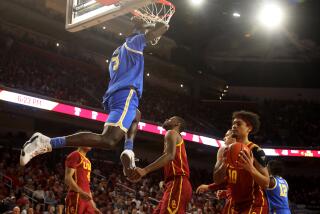Body and soul
BACK in 1978, after graduating from high school, about 20 of my friends went off to be college athletes. Some went with full scholarships, some went as walk-ins. Almost all were black. That fall, I visited two of my best friends, who were playing football for a Riverside County junior college. They’d been recruited by a celebrated coach and promised that they would be part of a great team.
It was cold the night they played and won. Afterward we went back to their place, a drafty wood-frame farmhouse in a fallow field. My friends shared it with three recruits from Florida. All they had to eat was powdered soup stirred into hot water in mugs. The guys from Florida could barely read or write. Two of them shared a single pair of dress shoes -- only one guy could go out at a time. But they helped their team win. They were fast and powerful, desperate and cold.
I’ve seen this scenario repeated over and over with my African American friends from childhood, from college; even now, I watch my friends’ children place all their hopes for the future in the hands of athletic directors and their sports scholarships.
So it was with great curiosity that I picked up William C. Rhoden’s “Forty Million Dollar Slaves: The Rise, Fall, and Redemption of the Black Athlete.” But the African American sportswriter’s new book is an enlightening, thoughtful and sometimes sentimental look at black males in sports from the early 1700s to the present. His thesis is that black athletes for hundreds of years have used superior physical ability as well as “soul and style” not only to thrill and entertain their fellow Americans but also to make money for white owners, yet they have been unable to control their own destinies.
The title may be off-putting -- an allusion to the 40 acres and a mule promised to freed slaves after the Civil War -- and the analogy of big-time sports as a plantation may seem to be a stretch, but Rhoden, a sportswriter for the New York Times since 1983, has done his homework. Indeed, those who follow sports have seen countless black athletes lay bodies on the line for teams, universities and professional organizations that reap large financial rewards, while the players too often get little, sometimes not even a college degree or a long career. The huge signing bonuses and contracts celebrated in the media go to only a tiny percentage of black athletes; many more make do at subsistence level, especially in college.
Rhoden, who played football at Baltimore’s Morgan State University in the late 1960s, includes the historic football game between Morgan and Louisiana’s Grambling State University played in Yankee Stadium in 1968. He was watching as a freshman from the sidelines as the all-black teams from two historically black colleges thrilled a national crowd. That game is the springboard for his meditations on how integration at the college and pro sports levels has dissipated black solidarity as expressed through sports.
He makes readers see and feel boxing matches and football games and outfield catches of the past. And he casts scene after scene of sporting contests in their larger historical context to show that black athletes have always had a unique place in American society.
Rhoden begins with Tom Molineaux, a former slave whose boxing career took him to England in the early 1800s to fight the British champion. Before he was an internationally known athlete, he was a plantation slave. “The most talented enslaved athletes not only earned respect among fellow slaves, but also garnered favor among owners, who saw their prowess as an outward extension of the owner’s own strength. For those in bondage, the image of the strong black body engaged in competition was a positive one, and a powerful symbol. The black athlete’s strength and grace presented a powerful counter-image to the prevailing stereotypes of blacks as slump-shouldered, shuffling bondsmen with heads bowed and knees bent.”
Rhoden writes about the Negro baseball leagues and about Jack Johnson, who became the first black to win the world heavyweight title in 1908. He recounts the fascinating and little-known history of black jockeys in America. He also traces the rising influence of top black athletes on modern American culture at nearly every level, through their performance, attitude, dress and sense of style.
Johnson, Rhoden writes, drove a cold realization through white America -- that a black athlete had surpassed a white one, and that he desired to show fellow African Americans his triumph in all its glory. Rhoden includes a quote about the boxer from a white writer of the era: “With money in his pockets, physical triumph over white men in his heart, he displayed all the gross and overbearing insolence which makes what we call the buck nigger insufferable.”
The book examines the integration of college football, the emerging dominance of black athletes in professional football and basketball, and the case of center fielder Curt Flood, a seven-time Gold Glove winner who in 1969 refused to be traded from the St. Louis Cardinals to the Philadelphia Phillies. “After twelve years in the major leagues, I do not feel that I am a piece of property to be bought and sold irrespective of my wishes,” Flood wrote to then-commissioner of baseball Bowie Kuhn.
Rhoden describes Flood’s lawsuit (which, though he lost, opened the way for others to become free agents), NBA player Larry Johnson’s controversial reference to fellow Knicks as “rebellious slaves” in 1999 and other such episodes as examples of the similarities between modern professional sports and plantations of the past.
It is, according to Rhoden, all about money. From the earliest days, when slave owners pitted their slaves against each other in races or matches, money was on the table. And now, when every schoolyard basketball player dreams of being drafted by the NBA, it’s still all about money. Think of only one example of the commodification of black style in sports -- the shoe industry -- and then think of the enormous profit made on shoes that cost a few dollars to manufacture overseas.
In a chapter called “The Conveyor Belt,” Rhoden describes how talented young black athletes and their families are “wooed and pursued with the promise of scholarships and, often, material gifts” for a sports industry that needs “a full-service delivery system to identify, prepare, and carry black muscle to ‘market.’ ”
I am reminded vividly of the night in the farmhouse, of watching the Florida ballplayers who’d been lured from their state by a coach who had promised them more than powdered soup. If young men (and young women, though this book doesn’t deal with female athletes) fall off that conveyor belt, they have nothing.
Rhoden’s theory is that integration, which has eroded cohesion in the black community, and commodification mean that black athletes still have very little power compared with white owners and coaches. What Rhoden really deplores, though, is not that some black athletes make amazing amounts of money while others don’t: He wants readers to understand how dissociated many successful black athletes are from black society, how disconnected they are from politics, power and team ownership. He contrasts this with an African American sporting culture in the first half of the 20th century -- which was a solidarity movement, in a sense, with Joe Louis and Jackie Robinson battling foes “for the race” and black people all over the nation listening intently, cheering not just for a particular athlete, but for themselves.
Interestingly enough, Rhoden’s tender evocation of his childhood and college years -- and his love for the history of sports -- make this book a powerful call for more black athletes to give back to their communities.
Otherwise, he writes, the system wins. “[T]he heart of the dilemma, I eventually came to understand, is the quest for power, power as illustrated by on-the-field representation, power as demonstrated in off-the-field control, power as symbolized by physical domination, power articulated as political revolution. The plantation is the enduring metaphor because that quest for power began with the attempt to assert control over our individual lives and freedom in the hellish years of literal bondage.” *
More to Read
Go beyond the scoreboard
Get the latest on L.A.'s teams in the daily Sports Report newsletter.
You may occasionally receive promotional content from the Los Angeles Times.











